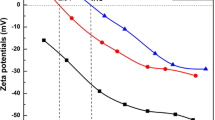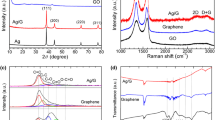Abstract
The effects of silver (Ag) modified on reduced graphene oxide (rGO) to improve the conductivity of rGO/copper composite were investigated via first-principle calculations and experimental investigations. It is found that after Ag ions deposited on rGO, some floccule of Ag deposits are formed and covered on the surface of rGO. The microstructure of rGO@Ag/Cu becomes much more uniform with less defects. The conductivity and electrical contact resistance of rGO@Ag/Cu composite also is better than that of rGO/Cu without any Ag modification. Micro-mechanism shows that the Ag modification can enhance the interface bonding strength of rGO@4Ag/Cu(111) (W = − 3.3213 J/m2) from initial W = − 0.5645 J/m2 of rGO/Cu. Electronic structure illuminates the improving conductivity and electrical contact resistance of rGO@Ag/Cu composite come from the best bridge effect of Ag ions between copper and carbon atoms. Furthermore its good electrical contact resistance is originated from the much more bonding strength of Ag–C than that of Cu–C. Thus our research can give some suggestions in the modification on graphene and the development of new electrical contact materials.











Similar content being viewed by others
Data availability
Our datasets of the paper are presented in the main manuscript.
References
D. Groppi, A. Pfeifer, D.A. Garcia, G. Krajai, N. Nui, A review on energy storage and demand side management solutions in smart energy islands. Revew. Sust. Energ. Rev. 135, 110183 (2021)
L. Cui, R. Luo, L. Wang, H. Luo, C. Deng, Novel copper-impregnated carbon strip for sliding contact materials. J. Alloys Compd. 735, 1846–1853 (2018)
S.P. Kumar, R. Parameshwaran, S.A. Kumar, S.N. Heenalisha, Electrical and mechanical studies on pure-silver coated aluminium based electrical contact materials. Mater. Today. Proc. 33, 3621–3625 (2020)
M. Lungu, S. Gavriliu, T. Canta, M. Lucaci, E. Enescu, AgSnO2 sintered electrical contacts with ultrafine and uniformly dispersed microstructure. Adv. Mater. 8, 576–581 (2006)
X. Wang, H. Yang, M. Chen, J. Zou, S. Liang, Fabrication and arc erosion behaviors of AgTiB2 contact materials. Powder. Technol. 256, 20–24 (2014)
J. Swingler, J.W. McBride, The erosion and arc characteristics of Ag/CdO and Ag/SnO2 contact materials under DC break conditions. IEEE Trans. Compon. Packag. Manuf. Technol. A 19, 404–415 (1996)
T. Yang, W. Chen, F. Yan, H. Lv, Y.Q. Fu, Effect of reduced graphene oxides decorated by Ag and Ce on mechanical properties and electrical conductivity of copper matrix composites. Vacuum 183, 109861–67 (2021)
Z. Yang, Z. Yao, G. Li, G. Fang, H. Nie, Z. Liu, X. Zhou, X. Chen, S. Huang, Sulfur-doped graphene as an efficient metal-free cathode catalyst for oxygen reduction. ACS Nano 6, 205–211 (2012)
M.M.S. Sanad, M.H. El-Sadek, Porous niobium carbide as promising anode for high performance lithium-ions batteries via cost-effective processing. Diamond Relat. Mater. 121, 108722 (2022)
M. Shi, H. Zhu, C. Chen, J. Jiang, L. Zhao, C. Yan, Synergistically coupling of graphene quantum dots with Zn-intercalated MnO2 cathode for high-performance aqueous Zn-ion batteries. Int. J. Min. Met. Mater. 30, 25–32 (2023)
Z. Lou, Q. Wang, W. Sun, J. Liu, H. Yan, H. Han, H. Bian, Y. Li, Regulating lignin content to obtain excellent bamboo-derived electromagnetic wave absorber with thermal stability. Chem. Eng. J. 430, 133178 (2022)
Z. Lou, Q. Wang, U.I. Kara, R.S. Mamtani, X. Zhou, H. Bian, Z. Yang, Y. Li, H. Lv, S. Adera, X. Wang, Biomass derived carbon heterostructures enable environmentally adaptive wideband electromagnetic save absorbers. Nano-Micro Lett. 14, 11 (2022)
H. Luo, Y. Sui, J. Qi, Q. Meng, F. Wei, Y. He, Copper matrix composites enhanced by silver/reduced graphene oxide hybrids. Mater. Lett. 196, 354–357 (2017)
H. Luo, Y. Sui, J. Qi, Q. Meng, F. Wei, Y. He, Mechanical enhancement of copper matrix composites with homogeneously dispersed graphene modified by silver nanoparticles. J Alloys Compd. 729, 293–302 (2017)
Y. He, S. Wang, H. Luo, C. Wang, Ag-rGO content dependence of the mechanical, conductive and anti-corrosion properties of copper matrix composites. Mater. Res. Express. 5, 096523 (2018)
S. Ghadimi, S. Mazinani, A.M. Bazargan, F. Sharif, Effect of formulation and process on morphology and electrical conductivity of Ag-graphene hybrid inks. Synth. Met. 281, 116913 (2021)
M. Singla, N. Jaggi, DFT analysis of hydrogen gas adsorption properties on Ag doped graphene. Mater. Today Proc. 66, 2104–2108 (2022)
M.D. Segall, P.J.D. Lindan, M.J. Probert, C.J. Pickard, P.J. Hasnip, S.J. Clark, M.C. Paync, First-principles simulation: ideas illustrations and the CASTEP code. J. Phys. Condens. Matter. 14, 2717–2744 (2002)
J.P. Perdew, K. Burke, M. Ernzerhof, Generalized gradient approximation made simple. Phys. Rev. Lett. 77, 3865–3868 (1996)
T.H. Fischer, J. Almlöf, General methods for geometry and wave function optimization. J. Phys. Chem. 96, 9768–9774 (1992)
C. Bi, C. Zhang, F. Ma, L. Zhu, R. Zhu, Q. Qi, L. Liu, H. Dong, Development of 3D porous Ag+ decorated PCN-222 @ graphene oxide-chitosan foam adsorbent with antibacterial property for recovering U(VI) from seawater. Sep. Purif. Technol. 281, 119900 (2022)
C. Cong, T. Yu, K. Sato, Raman characterization of ABA-and ABC-stacked trilayer graphene. ACS Nano 5, 8760–8768 (2011)
A. Berner, K.C. Mundim, D.E. Ellis, S. Dorfman, D. Fuks, R. Evenhaim, Microstructure of Cu–C interface in Cu-based metal matrix composite. Sensors Actuators A Phys. 74, 86–90 (1999)
L. Wang, K.C. Wei, F.L. Jia, Effect of graphene content on hardness and conductivity of copper matrix composites. Powder Metall. Ind. 31, 29–34 (2021)
U. Himmler, H. Peisl, A. Sepp, W. Waidelich, Effect of annealing on the lattice parameter of neutron-irradiated copper. Phys. Rev. Lett. 19, 956–957 (1967)
S. Yan, Q. Hong, X. Chen, X. Li, W. Nan, P. Peng, Reduced graphene oxide-refined Cu matrix composites: an experimental and first-principles study. Cryst. Res. Technol. 54, 1800191 (2019)
Y. Jiang, J.B. Adams, First principle calculations of benzotriazole adsorption onto clean Cu (111). Surf. Sci. 529, 428–442 (2003)
Y. Tan, H.Z. Zheng, G.F. Li, L.L. Xiong, P. Peng, Cohesive mechanism of the FeCr/Ni interface: a first-principles study. Met. Mater. Int. 22, 75–80 (2016)
Funding
This work was supported by the National Natural Science Foundation of China (Grant No. 520711362), the Jiangxi Provincial Natural Science Foundation (Grant No. 20202BABL204024), and the Innovation special fund project funding of Jiangxi graduate (Grant No.YC2018-S357).
Author information
Authors and Affiliations
Contributions
GL contributed to experimental and theoretical scheme and writing––original draft preparation. HL and ZD experimental validation and data curation. HW and JW experimental validation and data curation; PP did examination. All the authors have read and agreed to the published version of the manuscript.
Corresponding author
Ethics declarations
Conflict of interest
The authors declare that we have no conflict of interest.
Additional information
Publisher's Note
Springer Nature remains neutral with regard to jurisdictional claims in published maps and institutional affiliations.
Rights and permissions
Springer Nature or its licensor (e.g. a society or other partner) holds exclusive rights to this article under a publishing agreement with the author(s) or other rightsholder(s); author self-archiving of the accepted manuscript version of this article is solely governed by the terms of such publishing agreement and applicable law.
About this article
Cite this article
Li, G., Luo, H., Dong, Z. et al. Silver modification improving on the conductivity of graphene/copper composite: experimental and theoretical research. J Mater Sci: Mater Electron 34, 904 (2023). https://doi.org/10.1007/s10854-023-10328-7
Received:
Accepted:
Published:
DOI: https://doi.org/10.1007/s10854-023-10328-7




